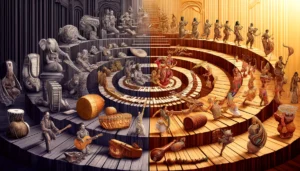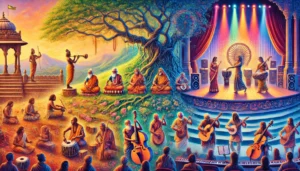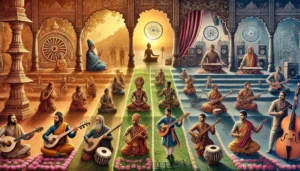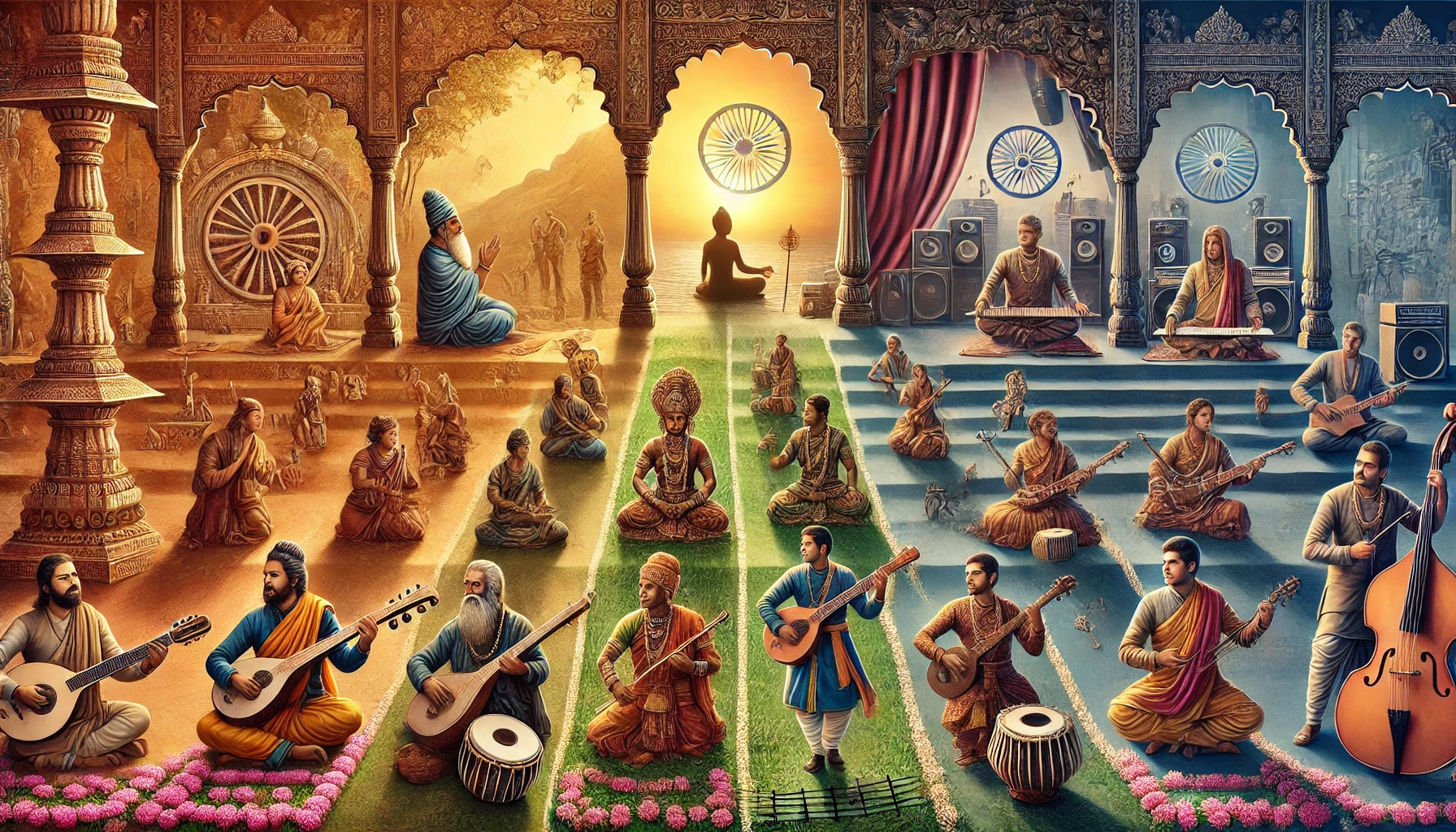
Evolution of Indian classical music
Evolution of Indian Classical Music: From Vedic Chants to Modern Fusion
Indian classical music is one of the most profound and enduring cultural legacies of the world. Steeped in spirituality, philosophy, and artistic finesse, it is both a timeless tradition and a dynamic art form. From the sacred chants of the Vedas to its fusion with global musical styles, Indian classical music has evolved significantly while maintaining its spiritual essence. This article explores the journey of this art form, delving deeper into its evolution across millennia.
The Vedic Period: The Genesis of Indian Music
The origins of Indian music lie in the Vedic period (1500–500 BCE), where it served as a medium for invoking divine energies. The hymns of the Samaveda, considered the earliest documentation of Indian music, were sung in specific melodies called sama gana. These melodies emphasized precise intonation, as they were believed to have spiritual and cosmic significance.
During this era, music was primarily functional and sacred, closely tied to religious ceremonies. Instruments like the veena (a string instrument) and dundubhi (a type of drum) were used as accompaniments, hinting at the early development of instrumental music. The emphasis was on maintaining the purity of sound and rhythm, as the chants were believed to connect humans to the divine.
The Natya Shastra: A Turning Point in Musical Theory
The Natya Shastra by Bharata, dating back to around 200 BCE to 200 CE, was a monumental text that systematized Indian music and dance. It introduced key concepts such as ragas (melodic frameworks) and talas (rhythmic cycles), which remain the foundation of Indian classical music to this day.
The Natya Shastra also outlined the emotional and aesthetic aspects of music, linking it to the rasas (emotions) that it could evoke. Music, according to this text, was not just entertainment but a means to transcend the mundane and attain higher states of consciousness.
It was during this time that music began to diversify into marga (sacred music) and desi (regional or folk music), paving the way for classical and folk traditions to flourish simultaneously.
Table of Contents

Evolution of Indian classical music
The Bhakti Movement: Music for the Masses
The Bhakti movement (7th–15th centuries) marked a profound shift in the purpose and accessibility of Indian music. Saints and poets like Mirabai, Tulsidas, and Purandaradasa composed devotional songs that resonated with the common people, breaking the barriers of caste and class.
This movement saw the birth of bhajans, kirtans, and other devotional forms that were sung in praise of deities. Music became a personal and emotional expression of devotion, emphasizing simplicity and accessibility over technicality.
In South India, this era also witnessed the rise of Carnatic music, with composers like Tyagaraja, Muthuswami Dikshitar, and Syama Sastri laying the foundation for its rich repertoire. Carnatic music retained its strong spiritual focus, with compositions largely centered on devotion and philosophy.
The Mughal Era: A Fusion of Cultures
The Mughal period (16th–18th centuries) brought Persian and Central Asian influences to Indian music, giving rise to Hindustani classical music in the northern part of the country. The Mughal courts became cultural hubs where music, art, and literature flourished.
This period saw the development of new forms like dhrupad, khayal, and tappa. While dhrupad emphasized spirituality and austerity, khayal introduced a more expressive and flexible style, allowing for greater improvisation.
Instruments like the sitar, sarod, and tabla were refined, becoming integral to Hindustani music. Legendary musicians like Tansen, who was part of Emperor Akbar’s court, were instrumental in elevating Indian classical music to new heights. Tansen’s compositions and innovations remain an inspiration to musicians even today.
Colonial Era: Challenges and Resilience
The advent of British colonial rule brought challenges to Indian classical music. Western musical styles and instruments began to dominate, and the patronage that classical musicians enjoyed in royal courts dwindled.
However, this period also saw efforts to preserve and revitalize Indian classical music. Visionaries like Pandit Vishnu Narayan Bhatkhande and Pandit Vishnu Digambar Paluskar played pivotal roles in codifying and institutionalizing classical music. They established music schools and documented ragas, ensuring that the tradition was systematically taught and passed on to future generations.
The colonial period also witnessed the beginnings of Indian classical music’s interaction with Western styles, as musicians started experimenting with new formats and instruments.
Post-Independence Renaissance: Revival and Global Impact
India’s independence in 1947 brought a renewed focus on cultural heritage, and Indian classical music experienced a resurgence. Legendary artists like Ravi Shankar (sitar), MS Subbulakshmi (Carnatic vocals), and Bismillah Khan (shehnai) emerged as global ambassadors of Indian music.
Ravi Shankar’s collaborations with Western musicians like George Harrison of The Beatles introduced Indian music to a global audience, sparking a wave of interest in its intricate rhythms and melodies. Similarly, Zakir Hussain’s mastery of the tabla helped popularize Indian percussion on international platforms.
In the south, Carnatic music flourished with artists like Lalgudi Jayaraman and Semmangudi Srinivasa Iyer preserving its classical purity while reaching wider audiences through concerts and recordings.
Modern Era: The Rise of Fusion and Digital Platforms
The modern era has witnessed the blending of Indian classical music with global genres like jazz, rock, and electronic music. Fusion artists like Shankar Mahadevan, Anoushka Shankar, and AR Rahman have brought innovative approaches to classical music, making it more accessible to younger audiences.
Digital platforms and streaming services have further democratized access to Indian classical music, allowing audiences across the globe to explore its vast repertoire. Online music schools and tutorials have also made it easier for aspiring musicians to learn and appreciate this rich tradition.

Evolution of Indian classical music
The Enduring Legacy of Indian Classical Music
Indian classical music, with its roots in spirituality and its branches extending to modern fusion, continues to inspire and evolve. It is not merely an art form but a profound expression of India’s cultural and philosophical ethos.
As it bridges the gap between tradition and innovation, Indian classical music stands as a testament to the timeless power of art to connect, heal, and transcend. Its journey from the sacred chants of the Vedas to the global stage of modern fusion is a story of resilience, adaptability, and unwavering devotion to the pursuit of beauty and truth.
Let us cherish and nurture this extraordinary legacy, ensuring that it continues to inspire generations to come.
FAQs on Indian Classical Music: Journey from Vedic Chants to Contemporary Fusion
1. What is Indian classical music, and how is it unique?
Indian classical music is a profound and intricate art form rooted in spirituality, philosophy, and cultural heritage. Its uniqueness lies in its emphasis on improvisation, intricate melodic structures (ragas), and complex rhythmic patterns (talas), creating a deep emotional connection with listeners.
2. What are the origins of Indian classical music?
The origins of Indian classical music trace back to the Vedic period (around 1500 BCE), where chants and hymns were recited with precise intonations to invoke spiritual energy. These early practices laid the foundation for the development of modern ragas and talas.
3. How did Vedic chants influence Indian classical music?
Vedic chants were based on specific tonal and rhythmic patterns that were used for meditation and rituals. The sacred chanting evolved into the Samaveda, which directly influenced the development of ragas in Indian classical music, emphasizing the connection between sound and spirituality.
4. How did regional and cultural diversity shape Indian classical music?
India’s vast cultural diversity allowed regional traditions to flourish, resulting in two distinct classical systems: Hindustani (North Indian) and Carnatic (South Indian) music. Each system reflects local influences, regional languages, and cultural practices, while sharing common roots in ancient traditions.
5. What are some key differences between Hindustani and Carnatic music?
Hindustani Music: Focuses on slow, expansive exploration of ragas, with an emphasis on improvisation and ornamentation. Popular styles include dhrupad, khayal, and thumri.
Carnatic Music: Follows a more structured approach, with compositions (kritis) forming the core. It places significant importance on rhythm and devotional themes.
6. What role did the Bhakti and Sufi movements play in Indian classical music?
The Bhakti movement in the South and the Sufi movement in the North profoundly influenced Indian classical music. These spiritual movements brought devotional elements, blending poetry and music to connect with the divine, which led to new styles such as bhajans and qawwalis.
7. How did Indian classical music evolve during the Mughal era?
The Mughal era (1526–1857) was a golden period for Hindustani music. It saw the emergence of khayal and dhrupad styles and the introduction of Persian instruments like the sitar and tabla. Court musicians like Tansen played a pivotal role in shaping this era’s music.
8. What is the connection between Indian classical music and spirituality?
Indian classical music is deeply intertwined with spirituality. Each raga is believed to evoke specific emotions and energies, often used in meditation and healing practices. The music is considered a path to connect with the divine and attain inner peace.
9. What are some notable instruments used in Indian classical music?
String Instruments: Sitar, veena, sarod, and tanpura.
Percussion Instruments: Tabla, mridangam, and ghatam.
Wind Instruments: Flute (bansuri) and shehnai.
Others: Harmonium and sarangi, which add unique textures to performances.
10. What are ragas, and why are they important?
Ragas are melodic frameworks based on specific notes and rules that evoke distinct moods or emotions. They are central to Indian classical music, guiding both compositions and improvisations.
11. How have modern artists contributed to Indian classical music?
Modern artists like Pandit Ravi Shankar, L. Subramaniam, Ustad Zakir Hussain, and AR Rahman have blended traditional classical music with global genres like jazz, rock, and electronic music, bringing Indian music to international audiences.
12. What is the role of improvisation in Indian classical music?
Improvisation is a hallmark of Indian classical music, allowing artists to explore the depth of ragas and express their creativity. This makes every performance unique and deeply personal.
13. How has Indian classical music influenced other genres?
Indian classical music has inspired a variety of genres, including Bollywood, fusion, and even Western music. Artists like The Beatles and John McLaughlin have incorporated Indian elements, popularizing its sounds globally.
14. What are some famous compositions or styles in Indian classical music?
Hindustani styles: Dhrupad, khayal, and thumri.
Carnatic compositions: Kritis by composers like Tyagaraja, Muthuswami Dikshitar, and Shyama Sastri.
Devotional forms: Bhajans and keerthanas.
15. How is Indian classical music taught and preserved today?
Traditionally taught through the guru-shishya parampara (teacher-student lineage), Indian classical music continues to thrive through formal institutions, online platforms, and music festivals.
16. What are some renowned festivals celebrating Indian classical music?
Notable festivals include the Sawai Gandharva Bhimsen Mahotsav, Tyagaraja Aradhana, and Dover Lane Music Conference. These festivals bring together maestros and enthusiasts, celebrating the rich legacy of Indian classical music.
17. How can Indian classical music contribute to mental well-being?
The melodic and rhythmic patterns of Indian classical music have been shown to reduce stress, improve focus, and promote emotional healing, making it a powerful tool for mental well-being.
18. What are the challenges faced by Indian classical music in the modern era?
Challenges include dwindling audiences, competition from mainstream entertainment, and the need to adapt to changing tastes while preserving tradition. However, efforts like fusion experiments and digital platforms are helping revive interest.
19. Can Indian classical music be fused with other musical genres?
Yes, fusion is a growing trend where artists blend Indian classical elements with global genres like jazz, EDM, and rock, creating innovative sounds while respecting classical roots.
20. How has technology impacted Indian classical music?
Technology has revolutionized Indian classical music by making it accessible globally through streaming platforms, online classes, and digital archives. It has also enabled collaborations and experiments with modern soundscapes.
Summary
The journey of Indian classical music is a fascinating evolution spanning thousands of years, deeply rooted in the spiritual and cultural traditions of the Indian subcontinent. It began with the Vedic chants, which were hymns composed in Sanskrit and recited in precise melodic patterns to invoke divine blessings. Over time, these chants laid the foundation for structured musical forms, giving rise to two primary traditions: Hindustani music in the north and Carnatic music in the south.
Throughout its evolution, Indian classical music has been enriched by contributions from saints, scholars, and royal patrons, blending indigenous traditions with influences from Persian, Mughal, and other cultures. Its rich tapestry includes ragas, intricate rhythms, and a focus on improvisation, reflecting a deep connection between music, nature, and spirituality.
In modern times, Indian classical music has transcended its traditional boundaries, merging with global genres like jazz, rock, and electronic music to create innovative fusion styles. This evolution showcases its timeless adaptability, ensuring its relevance and appeal to contemporary audiences while preserving its ancient essence. The journey of Indian classical music is a testament to its enduring legacy and its ability to bridge the past with the present.
Related Articles
- Restful Nights: Ayurvedic Remedies and Traditional Indian Practices to Overcome Insomnia and Late-Night Habits
- The Tridevi: Lakshmi, Saraswati, and Parvati – Their Roles and Powers
- “Divine Creatures of Ancient Indian Scriptures: Exploring the Role of Animals in the Vedas, Puranas, and Mahabharata”
- Nature and Spirituality: Exploring the Sacred Essence of the Himalayas, Ganga, and Other Natural Wonders”
- “Reviving the Gurukul System: Relevance and Lessons for Modern Education”
- “Exploring Greek and Indian Mythology: Similarities Between Greek and Indian Mythology “
- “Embracing Sattvic Living: Harmonizing Mind, Body, and Soul Through Food and Lifestyle”
- “Charity and Prosperity: Exploring the Concept of Daan and Its Financial Relevance in Modern Life”
- How to Build an Eco-Friendly Home Inspired by Vastu Shastra
- Comparison of Ancient and Modern Sports: How Traditional Sports Have Influenced Contemporary Games
- “Timeless Lessons from Ancient Tales: Linking Samudra Manthan and Ganga’s Descent to Modern Ecological Challenges”
- “Reviving Sanskrit: How AI is Preserving Ancient Languages for the Future”
- “Mathura: The Sacred Land of Lord Krishna’s Divine Leelas”
- Investing for Future Generations: Lessons from Indian Traditions on Legacy Building and Wealth Preservation
- “Ancient Indian Wisdom: Timeless Lessons for Tackling Today’s Climate Crisis”
- “Artificial Intelligence and Spirituality: Transforming Ancient Practices for the Modern World”
- “Gold and Real Estate in India: Timeless Assets Shaping Financial Strategies”
- Tradition Meets Innovation: The Evolution of Technology in Hindu Rituals
- End-of-World Myths: Exploring Kali Yuga in Hinduism and Ragnarök in Norse Mythology
- Garuda, Pegasus, and Dragons: The Universal Ties of Mythical Beasts Across Cultures
- “Ancient Vimanas: Mythical Flying Machines or Evidence of Advanced Technology?”
- Time Travel in Hindu Mythology: The Fascinating Tales of Kakudmi and King Raivata
- “Divine Feminine Power in Hindu Mythology: The Legends of Durga, Saraswati, and Lakshmi”
- “Divine Beings of Sanatan Dharma: The Spiritual Significance of Sacred Animals in Hinduism”
- “Symbolism in Mythological Art: Unlocking Hidden Meanings in Ancient Temple Carvings”
- “Exploring Technological Advancements in Ancient India and Civilizations: Vimana, Metallurgy, & Water Management systems”
- Unveiling the Mysteries: Ancient Temples of Sanatan Dharma , Mysterious Temples of India
- “The Scientific Knowledge of Sanatan Dharma: Ancient Wisdom Meets Modern Science”
- Ancient Indian Sports and Games: Celebrating a Legacy of Skill, Strength & Strategy”
- “Exploring the Cosmic Link: The Connection Between Astronomy and Vedic Astrology”
- The Power of Sanskrit: Unlocking the Divine Language of the Gods
- “The End of Kaliyuga: A Sanatan Insight into the World’s Final Chapter”
- Explore more articles on Prachin Sanatan Yuga.
Unlock the Ancient Wisdom of Sanatan Dharma – Join Us on YouTube!
👉 Subscribe now to Prachin Sanatan Dharma and embark on a journey of enlightenment.
Explore timeless teachings, spiritual insights, and cultural richness on our YouTube channel, Prachin Sanatan Dharma. Dive deep into the essence of Sanatan Dharma through captivating videos that inspire and educate.
Evolution of Indian classical music Evolution of Indian classical music Evolution of Indian classical music Evolution of Indian classical music Evolution of Indian classical music Evolution of Indian classical music Evolution of Indian classical music Evolution of Indian classical music Evolution of Indian classical music Evolution of Indian classical music Evolution of Indian classical music
Evolution of Indian classical music Evolution of Indian classical music Evolution of Indian classical music Evolution of Indian classical music Evolution of Indian classical music Evolution of Indian classical music Evolution of Indian classical music Evolution of Indian classical music Evolution of Indian classical music Evolution of Indian classical music Evolution of Indian classical music
Evolution of Indian classical music Evolution of Indian classical music Evolution of Indian classical music Evolution of Indian classical music Evolution of Indian classical music Evolution of Indian classical music Evolution of Indian classical music Evolution of Indian classical music Evolution of Indian classical music Evolution of Indian classical music Evolution of Indian classical music
